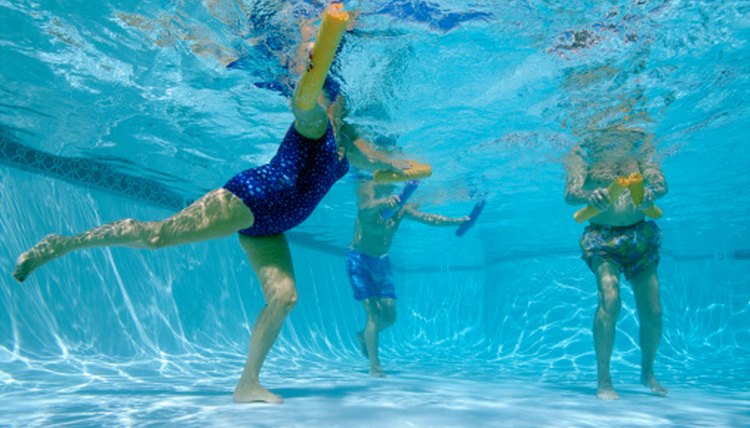Water Exercises for Hip Replacements

Hip replacement is major surgery, but it gives those suffering extreme joint pain and stiffness back their mobility. Getting moving as soon as possible post-surgery benefits your health; jfollow your doctor's advice as to when and how you should exercise. Working out in the water keeps you buoyant and steady as you recover from from hip replacement surgery.
Stretching
Water exercise allows you start rehabilitation even if you are not yet able to perform weight-bearing exercise, according to Joanne M. Koury, author of "Aquatic Therapy Programming: Guidelines for Orthopedic Rehabilitation." Regaining your range of motion after hip replacement surgery is an important first step to recovery. You gradually increase the extent of your movements, always careful to keep them under 90 degrees, explains Linda Huey on HipHealth.com. Examples of stretching exercises include hip abductions and hip extensions. You tackle the more advanced shallow squats as advised by your physical therapist and health care professionals and take care to keep your movements within the limits prescribed by them. Start walking in water in short increments and in waist-deep water, advises Koury. A few minutes of walking forward in waist deep water gets you moving without putting full weight on your hip joints.
Regaining Strength
Once you feel confident in the water and gain back some flexibility in your hips and legs, you work on regaining strength. You continue with forward walking in shallow or waist-deep water and add walking backwards and then side stepping to the regimen. Increase the length of your walking sets as advised by your physical therapist. Exercising your legs and hips by flutter kicking for less than one minute is a good start to building leg strength. Do not use fins, though, as they increase the resistance to your movements. Position yourself in a corner of the pool, placing your arms over the deck edge to stabilize yourself, and perform bicycle movements increasing speed as you progress. Increase your speed as you progress, recommends HipHealth.com. Eventually you bring your knees above the water, increasing the difficulty of the exercise. Using a flotation belt, and keep yourself vertical and stable in deep water using sculling motions with your hands. Sculling means making circular movements, palms facing down on the surface of the water. Let your body rest, suspended in the water.
Endurance/Impact
The hydrostatic pressure of water increases your blood circulation and helps reduce swelling or edema, according to Koury, and so it is a good environment to continue recuperation from hip replacement surgery. Water jogging in deep water with the use of a flotation belt protects you from the effects of gravity while you build up endurance and improve your fitness levels. When your therapist says you are able, start doing impact exercises in the shallow end of the pool. Include lunges, squats and jumps and "cross-country skiing" moves to add some weight bearing exercise in to the mix. Maintaining fitness and range of motion after your recovery period ends is essential to keep fit as you move forward.
References
Writer Bio
Barrett Barlowe is an award-winning writer and artist specializing in fitness, health, real estate, fine arts, and home and gardening. She is a former professional cook as well as a digital and traditional artist with many major film credits. Barlowe holds a Bachelor of Arts in English and French and a Master of Fine Arts in film animation.
